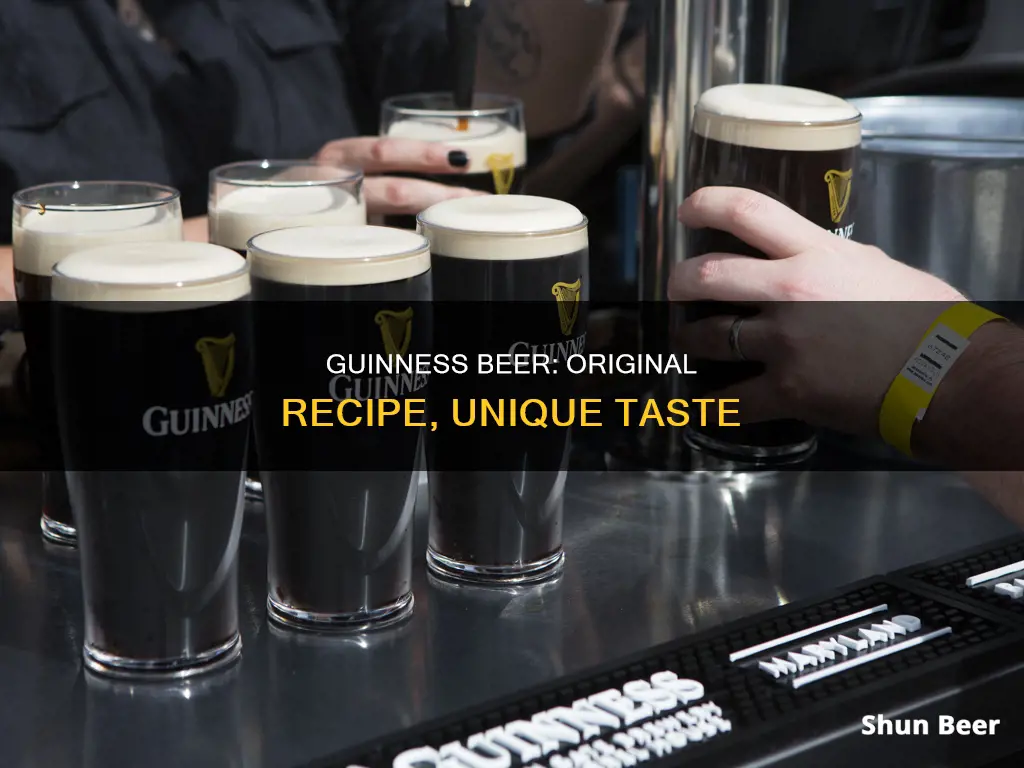
Guinness is a stout that originated in the brewery of Arthur Guinness at St. James's Gate, Dublin, Ireland, in the 18th century. It is one of the most successful alcohol brands worldwide, brewed in almost 50 countries and available in over 120. Guinness Extra Stout, based on a recipe from 1821, is the flagship beer that remains what pretty much every other release is based on. It is a classic, and generous on the nose with pronounced malted milkshake notes. The flavours are pleasantly even, made up of cacao, nutty notes, cola, molasses, and even a pinch of fruity esters. The finish is elegant, like a sip of coffee after a nibble of a chocolate chip cookie.
| Characteristics | Values |
|---|---|
| Brewery | St. James's Gate Brewery, Dublin |
| Founder | Arthur Guinness |
| Year founded | 1759 |
| Headquarters | London |
| Parent company | Diageo |
| Beer type | Stout |
| Colour | Dark shade of ruby |
| Ingredients | Water, barley, hops, yeast roast malt extract, brewer's yeast |
| Dispensing gas | Nitrogen |
| Alcohol by volume | 4.1% to 4.3% |
What You'll Learn

The history of Guinness
Guinness, formerly known as Arthur Guinness & Sons PLC and Arthur Guinness Son & Co. Ltd., was founded when Arthur Guinness bought a small brewery in Dublin in 1759. Initially, the brewery produced a variety of ales and beers, but in 1799, it shifted its focus exclusively to porter, a dark beer with a rich head. The beer later became known as stout and prospered, eventually becoming regarded as the national beer of Ireland.
Arthur Guinness died in 1803, and his son, Arthur Guinness II, took over the family business. Under his leadership, sales of Guinness expanded significantly in Great Britain. By 1833, Guinness had become the largest brewery in Ireland, and by 1886, it was the world's largest brewery, producing 1.2 million barrels annually.
In 1801, Arthur Guinness II introduced West Indies Porter, which was later renamed Foreign Extra Stout. This beer is the longest continually brewed recipe in the history of Guinness and has become the number one selling beer in the company's portfolio. It is sold in almost 180 countries and is particularly popular in Nigeria, where the number of Guinness drinkers is higher than in all of Ireland.
In 1821, Arthur Guinness II released another iconic beer, Guinness Extra Stout. Sharper and crisper than Guinness Draught and Foreign Extra Stout, this beer falls into the classic Irish dry stout category and is considered the quintessential stout by many at the company.
In 1959, to commemorate its bicentennial, Guinness released Guinness Draught Stout. This beer is known for its distinctive can or draft handle and pillowy texture. The foamy head, created by micro bubbles, is a defining characteristic of this nitro-style beer.
Guinness has had a long history of marketing campaigns, from iconic television advertisements to beermats and posters. One of its most notable and recognisable series of advertisements was created by S. H. Benson's advertising in the 1930s and 1940s, with slogans such as "Guinness for Strength" and "Guinness is Good for You".
Today, Guinness stands as the largest brewer of stout in the world, with products available in almost 50 countries and sold in over 120. It is owned by Diageo, a British multinational beverage company, and the Guinness Storehouse at St. James's Gate Brewery in Dublin is the most popular tourist attraction in Ireland.
Guinness Blonde Ale: Wheat Beer or Not?
You may want to see also

Guinness Extra Stout
The beer is dark ruby red with a frothy head and has a subtly fruity aroma with warming, roasted notes of coffee and dark chocolate. It is sharp and crisp to the taste, with trademark Guinness flavours at its core. It is also described as having a distinct bite and being “heavier bodied (though not a heavy beer), maltier, carbonated, and distinctly more bitter…even sour to a point".
The Extra Stout is also noted for its unique character and flavour, which has been maintained for over two centuries. It is considered a "must-try for any stout lover" and has received generally positive reviews, with some noting that it is a "perfect example of style". However, some drinkers may prefer the more widely available Guinness Draught, which has a smoother mouthfeel.
Guinness: A Dark Porter Beer With a Rich History
You may want to see also

Guinness Draught
The history of Guinness Draught is actually two-fold. Firstly, in the mid-20th century, brewers began using single stainless steel kegs to store beer instead of a two-barrel system. Guinness needed to recreate the two-part pour, which involves blending a cask of fresh, lively beer with a cask of flatter, more aged beer, in a single keg. In 1951, Guinness hired Michael Ash to tackle this problem, and after five years, he developed the "Ash Can". This was a two-part keg, with one chamber full of beer and the other full of a mixed gas under pressure (25% carbon dioxide and 75% nitrogen). The two were combined during the serve, creating a nitrogenated pour with a creamy texture and a frothy, milky head.
Secondly, in the 1980s, Guinness launched a draught version in a can, containing a specially engineered widget. When the can is opened, the widget releases pressurised nitrogen, creating a surge and settle effect and giving the beer a head.
Guinness Beer: High Iron Content or Just a Myth?
You may want to see also

Guinness advertising campaigns
Guinness's advertising campaigns are known throughout the world. The company's first advertising tagline, "Guinness is Good For You," dates back to 1794. Since then, the brand has produced numerous memorable campaigns that have become almost as iconic as the drink itself.
In the 1930s, after a slump in sales, Guinness decided to invest in advertising and enlisted the help of Bensons, a heavyweight advertising agency. They created a poster campaign featuring slogans like "Guinness for Strength" and "Guinness Makes You Strong." However, the most well-known slogan was "Guinness is Good for You," which became synonymous with the brand.
In the early 1950s, Guinness introduced the toucan as its mascot, which has become as recognisable as the brand's harp symbol. To bring their posters to life, they produced a television advert featuring toucans descending on an army mess and stealing the soldiers' beer. This ad ran in the UK, America, and Canada and is still well-remembered today.
One of Guinness's most iconic adverts is the "Surfer" TV commercial, which first aired in 1998. Directed by Jonathan Glazer, it features surfers waiting on the beach for the perfect wave. When it arrives, they are surprised by horses rising out of the water. The advert, with its pounding beat, became immensely popular as it didn't focus on the product but on the emotions of achievement and the power of cinematography.
In 2014, Guinness ran a campaign centred around the Sapeurs, or the Society of Elegant Persons of Congo. The advert followed Congolese men through their workday, ending with them dressing up and attending a Sapeurs event, dancing and enjoying drinks. This lighthearted campaign promoted the idea that these men were more than their daily struggles, ending with the quote, "Made of More."
Guinness has also utilised social media to create buzz around its campaigns, such as with the hashtag #MadeOfBlack for its Black Lager campaign, featuring short, snappy clips set to Kanye West's song, BLKKK SKKKN HEAD.
Through innovative and memorable campaigns, Guinness has set itself apart from the usual beer ads, solidifying its place in the advertising world.
Stouts Similar to Guinness: Exploring Dark Beer Alternatives
You may want to see also

Guinness Storehouse
The Guinness Storehouse is a tourist attraction at St. James's Gate Brewery in Dublin, Ireland. It has been a working brewery for over 250 years and has received over twenty million visitors since opening to the public in 2000.
The Storehouse covers seven floors surrounding a glass atrium shaped like a giant pint of Guinness. The ground floor introduces the beer's four ingredients (water, barley, hops and yeast), and the brewery's founder, Arthur Guinness. On the ground floor, you can also see the 9,000-year lease signed by Arthur Guinness in 1759. On other floors, you can learn about the history of Guinness advertising and take part in an interactive exhibit on responsible drinking.
The seventh floor houses the Gravity Bar, which offers panoramic views of Dublin. Here, visitors can enjoy a complimentary pint of Guinness, included in the price of admission. The Brewery Bar on the fifth floor offers Irish cuisine, with Guinness incorporated into the cooking and as an accompaniment to food.
The Guinness Storehouse also contains the Guinness Archives, which hold records and artefacts dating back to 1759.
Guinness: The Healthiest Beer Option?
You may want to see also
Frequently asked questions
Guinness Draught was introduced in 1988 as a canned version of the draught Guinness in pubs. It has a smooth, creamy texture and is served with a mixture of nitrogen and carbon dioxide gases. Guinness Original, also known as Guinness Extra Stout, is a more assertive character with a rocky and jagged head made of tiny bubbles. It has a sharper taste due to its higher carbonation level.
Guinness was founded by Arthur Guinness in 1759 when he bought a small brewery in Dublin. Initially, the brewery produced a variety of ales and beers, but in 1799, it shifted its focus entirely to porter, a dark beer with a rich head. The beer later became known as stout and prospered, becoming regarded as Ireland's national beer.
Guinness Extra Stout is the older of the two, with a recipe dating back to 1821. It is a classic stout with a complex flavour profile, including notes of cacao, nutty flavours, cola, molasses, and fruity esters. Guinness Draught, on the other hand, is a newer creation with a creamy texture and a foamy head. It has mild aromatics and a bitter finish.







